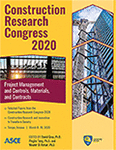Construction Research Congress 2020
Toward Automated Virtual Assembly for Prefabricated Construction: Construction Sequencing through Simulated BIM
Publication: Construction Research Congress 2020: Project Management and Controls, Materials, and Contracts
ABSTRACT
To adhere to the stringent time and budget requirements of construction projects, contractors are utilizing prefabricated construction methods to expedite the construction process. Prefabricated construction methods require an adequate schedule and understanding by the contractors and constructors to be successful. The specificity of prefabricated construction often leads to inefficient scheduling and costly rework time. The designer, contractor, and constructors must have a strong understanding of the assembly process to experience the full benefits of the method. At the root of understanding the assembly process is visualizing how the process is intended to be performed. Currently, a virtual construction model is used to explain and better visualize the construction process. However, creating a virtual construction model is currently time consuming and requires experienced personnel. The proposed simulation of the virtual assembly will increase the automation of virtual construction modeling by implementing the data available in a building information modeling (BIM) model. This paper presents various factors [i.e., formalization of construction sequence based on the level of development (LOD)] that needs to be addressed for the development of automated virtual assembly. Two case studies are presented to demonstrate these factors.
Get full access to this article
View all available purchase options and get full access to this chapter.
ACKNOWLEDGEMENT
This work was partially funded under Versatile Test Reactor Program of the U.S. Department of Energy (DOE) by Battelle Energy Alliance, LLC (BEA), the Management and Operating Contractor of Idaho National Laboratory (INL) under Contract Number DE-AC07-05ID14517 with DOE. The United States Government has a non-exclusive, paid-up, irrevocable, world-wide license to publish and reproduce the published form of this work and allow others to do so, for United States Government purposes. Any opinions, findings, conclusions and/or recommendations expressed in this paper are those of the authors and do not reflect the views of the entities above.
REFERENCES
Abou-Ibrahim, H., & Hamzeh, F. (2016). Enabling lean design management: An LOD based framework. Lean Construction Journal, 2016, 12–24.
AbouRizk, S., Halpin, D., Mohamed, Y., & Hermann, U. (2011). Research in Modeling and Simulation for Improving Construction Engineering Operations. Journal of Construction Engineering and Management, 137(10), 843–852. https://doi.org/10.1061/(asce)co.1943-7862.0000288
Anvari, B., Angeloudis, P., & Ochieng, W. Y. (2016). A multi-objective GA-based optimisation for holistic Manufacturing, transportation and Assembly of precast construction. Automation in Construction, 71(Part 2), 226–241. https://doi.org/10.1016/j.autcon.2016.08.007
Beard, R. W., & McLain, T. W. (2015). 12. Path Planning. Small Unmanned Aircraft. https://doi.org/10.1515/9781400840601-013
Chen, J. H., Yang, L. R., & Tai, H. W. (2016). Process reengineering and improvement for building precast production. Automation in Construction, 68, 249–258. https://doi.org/10.1016/j.autcon.2016.05.015
Ding, L., Li, K., Zhou, Y., & Love, P. E. D. (2017). An IFC-inspection process model for infrastructure projects: Enabling real-time quality monitoring and control. Automation in Construction, 84(August), 96–110. https://doi.org/10.1016/j.autcon.2017.08.029
Hooper, M. (2015). Automated model progression scheduling using level of development. Construction Innovation, 15(4), 428–448. https://doi.org/10.1108/CI-09-2014-0048
Howe, S. (2000). Designing for automated construction. Automation in Construction, 9(3), 259–276. https://doi.org/10.1016/S0926-5805(99)00041-2
Kayhani, N., Taghaddos, H., Noghabaee, M., Ulrich, & Hermann. (2019). Utilization of Virtual Reality Visualizations on Heavy Mobile Crane Planning for Modular Construction. https://doi.org/10.22260/ISARC2018/0170
Li, Z., Shen, G. Q., & Xue, X. (2014). Critical review of the research on the management of prefabricated construction. Habitat International, 43, 240–249. https://doi.org/10.1016/j.habitatint.2014.04.001
Noghabaei, M., Asadi, K., & Han, K. (2019). Virtual Manipulation in an Immersive Virtual Environment: Simulation of Virtual Assembly.
Reddy, H. (2013). PATH FINDING - Dijkstra ’ s and A * Algorithm ’ s, 1–15.
Taghaddos, H., Hermann, U., & Abbasi, A. (2018). Automated Crane Planning and Optimization for modular construction. Automation in Construction, 95, 219–232. https://doi.org/10.1016/J.AUTCON.2018.07.009
Tserng, H. P., Yin, Y. L., Jaselskis, E. J., Hung, W. C., & Lin, Y. C. (2011). Modularization and assembly algorithm for efficient MEP construction. Automation in Construction, 20(7), 837–863. https://doi.org/10.1016/j.autcon.2011.03.002
Wang, C., Wang, L., Qin, J., Wu, Z., Duan, L., Li, Z., … Wang, Q. (2015). Path planning of automated guided vehicles based on improved A-Star algorithm. 2015 IEEE International Conference on Information and Automation, ICIA 2015 - In Conjunction with 2015 IEEE International Conference on Automation and Logistics, (August), 2071–2076. https://doi.org/10.1109/ICInfA.2015.7279630
Xie, H., Chowdhury, M. M., Issa, R. R. A., & Shi, W. (2018). Simulation of Dynamic Energy Consumption in Modular Construction Manufacturing Processes. Journal of Architectural Engineering, 24(1), 04017034. https://doi.org/10.1061/(ASCE)AE.1943-5568.0000289
Zhao, N., Kam, C., T. Y. Lo, J., Kim, J. I., Fischer, M. (2018). Construction Parts in Building Projects: Definition and Case Study. Journal of Management in Engineering, 34(4), 04018014. https://doi.org/10.1061/(asce)me.1943-5479.0000616
Information & Authors
Information
Published In
Construction Research Congress 2020: Project Management and Controls, Materials, and Contracts
Pages: 802 - 811
Editors: David Grau, Ph.D., Arizona State University, Pingbo Tang, Ph.D., Arizona State University, and Mounir El Asmar, Ph.D., Arizona State University
ISBN (Online): 978-0-7844-8288-9
Copyright
© 2020 American Society of Civil Engineers.
History
Published online: Nov 9, 2020
Published in print: Nov 9, 2020
Authors
Metrics & Citations
Metrics
Citations
Download citation
If you have the appropriate software installed, you can download article citation data to the citation manager of your choice. Simply select your manager software from the list below and click Download.
